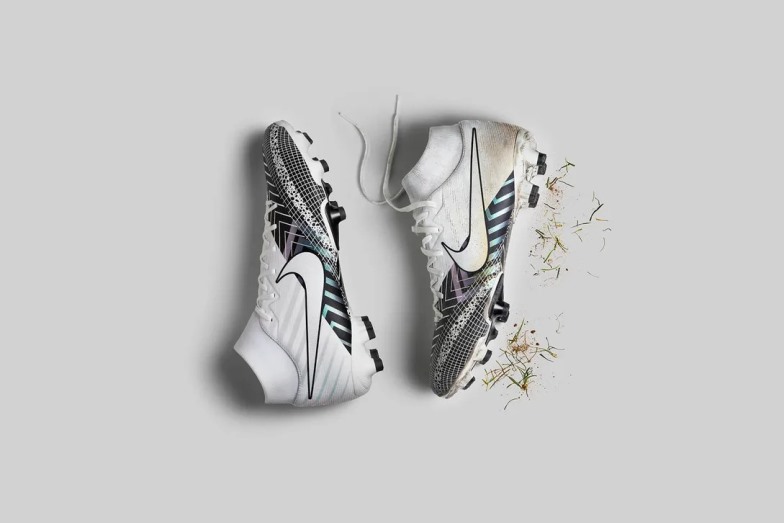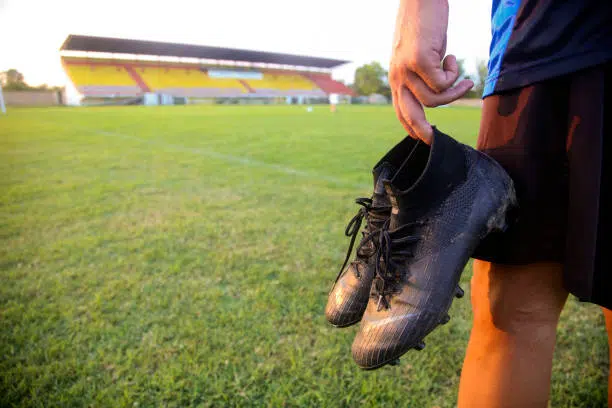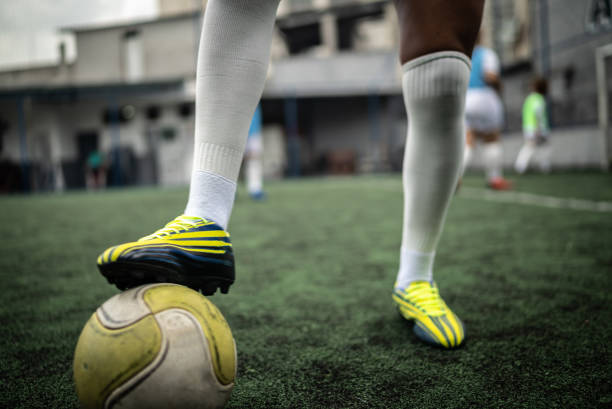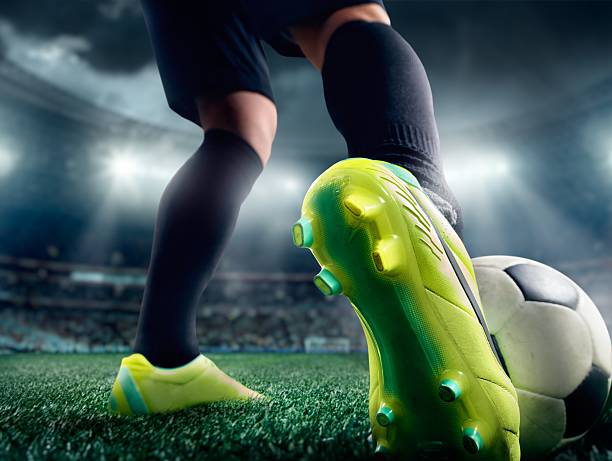Introduction: A Common Conundrum
Can you wear soccer cleats for football? If you’ve ever stood before a wall of cleats, you may have wondered if those sleek soccer shoes could double as football boots. It’s a common question for athletes, especially when trying to balance performance with practicality. While soccer and football cleats are both designed to enhance traction, performance, and safety on the field, there are critical differences between them that may impact your game. Let’s explore whether wearing soccer cleats for football is a good idea and dive into the distinct features of each type of footwear.
The Core Differences Between Soccer and Football Cleats

Understanding the differences between soccer and football cleats is crucial to making an informed decision. Each type of cleat is engineered with specific features tailored to the demands of its respective sport. These differences can significantly impact performance, comfort, and safety.
Soccer Cleats: Designed for Precision
Soccer cleats are crafted with agility and control in mind. Their features include:
- Low Profile: Soccer cleats sit close to the ground to enhance stability and control. This design allows players to have better foot-to-ball interaction, which is essential for precise dribbling, passing, and shooting.
- Lightweight: They are designed to be light, aiding in quick movements and long sprints. The lightweight nature of soccer cleats helps players maintain their speed and endurance throughout the game, which is particularly important during high-intensity matches.
- Minimal Padding: Emphasis is on foot feel and touch, rather than protection. Soccer players rely heavily on their ability to feel the ball through their cleats, making minimal padding a desirable feature for maintaining a good touch on the ball.
- Stud Configuration: Typically includes shorter studs, suitable for firm ground and turf. The stud pattern is designed to provide optimal traction and stability on natural grass and artificial surfaces, allowing players to make quick turns and sudden stops with ease.
Football Cleats: Built for Strength and Protection
Football cleats, on the other hand, prioritize power and safety:
- Higher Ankle Support: Often, football cleats come with higher tops to provide ankle stability. This feature is particularly important for football players who engage in frequent lateral movements and high-impact collisions, which can put a strain on their ankles.
- Heavier Build: The robust design helps in absorbing impacts. Football is a contact sport that involves tackling and blocking, requiring cleats that can withstand significant physical stress.
- Enhanced Padding: Protection against hard tackles and physical play is crucial. Football cleats are designed with extra padding to protect the feet from impacts and to provide additional comfort during long games.
- Varied Stud Lengths: Depending on the position, cleats may have longer studs for traction. The stud configuration in football cleats can vary widely, with longer studs providing better grip on softer, muddier fields, and shorter studs suitable for firmer surfaces.
Can Soccer Cleats Be Used for Football?

Positional Play and Cleat Choice
The answer isn’t a simple yes or no. It depends significantly on the position you play in football. Different positions have unique demands, and your cleat choice should reflect these requirements.
Skill Positions: Quarterbacks, Wide Receivers, and Defensive Backs
For players in these positions, agility and speed are paramount. Soccer cleats can offer:
- Enhanced Mobility: Their lightweight design facilitates quick cuts and sprints. Players in skill positions need to make rapid changes in direction and accelerate quickly, and soccer cleats can provide the necessary flexibility and responsiveness.
- Improved Ball Feel: Kicking and handling the ball can feel more natural. Soccer cleats are designed for precise ball control, which can be beneficial for quarterbacks who need to make accurate passes and for wide receivers who need to catch the ball cleanly.
However, there are also potential downsides to consider. The lack of ankle support in soccer cleats can increase the risk of injury during high-impact plays, and the stud configuration might not provide the best traction on certain types of football fields.
Linemen: Offensive and Defensive Line
Here, soccer cleats might fall short:
- Insufficient Support: The lack of ankle support can be a drawback. Linemen engage in frequent pushing and shoving, which can put a significant strain on their ankles. Football cleats with higher tops provide the necessary stability to prevent injuries.
- Reduced Durability: Football’s physical demands may wear out soccer cleats quickly. The constant physical contact and aggressive movements can cause soccer cleats to deteriorate faster, making them a less durable option for linemen.
In summary, while soccer cleats can be suitable for some football positions, they may not provide the necessary support and durability for others. It’s important to consider your specific needs and playing style when choosing cleats.
Performance and Safety Considerations

Traction and Stability
Traction is vital in both sports but manifests differently:
- Soccer Cleats: Provide consistent traction on grass and turf. The stud pattern in soccer cleats is designed to offer balanced traction and stability, allowing players to maintain control on both natural and artificial surfaces.
- Football Cleats: Offer specialized traction based on position and field type. Football cleats are tailored to provide optimal grip for various playing conditions, with longer studs for muddy fields and shorter studs for firmer ground.
Proper traction is essential for preventing slips and falls, which can lead to injuries. Choosing the right cleats for your playing surface and position can enhance your performance and reduce the risk of accidents.
Ankle and Foot Protection
- Soccer Cleats: Minimalist design may leave ankles exposed. The low-cut design of soccer cleats prioritizes mobility over protection, which can be a disadvantage in football’s contact-heavy environment.
- Football Cleats: Added padding and support protect against impacts. Football cleats are designed with extra cushioning and ankle support to protect players from the physical demands of the sport, reducing the risk of injuries.
When choosing cleats, it’s important to consider the level of protection you need. Soccer cleats may be suitable for non-contact drills and casual play, but football cleats offer better protection for competitive games.
Comfort and Fit
Comfort is subjective and varies from player to player:
- Soccer Cleats: Typically narrow and form-fitting. Soccer cleats are designed to provide a snug fit, which can enhance ball control but may be uncomfortable for players with wider feet.
- Football Cleats: May offer a wider fit with more cushioning. Football cleats are often designed with a roomier fit and additional padding to accommodate the physical demands of the sport and provide extra comfort during long games.
Finding the right fit is crucial for both performance and comfort. Trying on different types of cleats and considering your foot shape can help you find the best option for your needs.
Personal Experience and Player Testimonials
Professional Insights
Professional athletes often share their preferences:
- Dual-Sport Athletes: Some find soccer cleats beneficial for football training sessions due to their lightweight nature. Athletes who play both sports may appreciate the versatility of soccer cleats for certain drills and conditioning exercises.
- Football Players: Most prefer sport-specific cleats during games for optimal performance. Professional football players typically choose cleats that provide the necessary support, traction, and protection for their position and playing style.
Youth and Amateur Perspectives
Youth players might choose based on availability and cost:
- Versatility: Soccer cleats are a versatile option for multiple sports. For young athletes who participate in various sports, soccer cleats can be a practical and cost-effective choice.
- Affordability: Cost-effective for families with multi-sport children. Soccer cleats are often more affordable than football cleats, making them a popular choice for families looking to save money.
Player testimonials can provide valuable insights into the pros and cons of different cleats. Listening to the experiences of others can help you make an informed decision based on your own needs and preferences.
The Impact on Performance Metrics
Speed and Agility
- Soccer Cleats: Can enhance speed due to their lightweight design. The minimal weight of soccer cleats allows players to move quickly and change direction with ease, which can be advantageous for skill positions in football.
- Football Cleats: Balance between speed and protection. While football cleats may be heavier, they provide the necessary protection and support for high-impact plays, ensuring that players can perform at their best without compromising safety.
Injury Prevention
Injury rates can be influenced by cleat choice:
- Soccer Cleats: Risk of ankle injuries due to lower support. The low-cut design of soccer cleats can leave ankles vulnerable to twists and sprains, particularly during high-intensity football games.
- Football Cleats: Better suited for the physicality of football, reducing injury risk. The added ankle support and cushioning in football cleats help protect players from the physical demands of the sport, reducing the likelihood of injuries.
Choosing the right cleats can have a significant impact on your performance and injury risk. It’s important to consider the specific demands of your position and playing style when selecting footwear.
Practical Scenarios: When to Choose Soccer Cleats
Training Sessions
For non-contact drills and conditioning:
- Soccer Cleats: Ideal for agility drills and speed work. The lightweight design and flexible stud pattern of soccer cleats make them suitable for drills that focus on speed, agility, and ball control.
- Varied Workouts: Soccer cleats can be used for a range of training exercises, from sprinting to footwork drills. Their versatility makes them a valuable addition to any athlete’s training regimen.
Low-Impact Games
In casual, non-contact games:
- Soccer Cleats: Can be a comfortable and practical choice. For informal, friendly games where the intensity and physical contact are lower, soccer cleats can provide the necessary traction and flexibility without the need for additional protection.
- Affordability and Accessibility: Soccer cleats are often more affordable and widely available, making them a convenient option for recreational players who do not want to invest in multiple pairs of sport-specific shoes.
- Adaptability: Their design makes them suitable for various playing surfaces, from grassy fields to artificial turf, enhancing their practicality for multi-sport use.
The Final Verdict: Situational Use
Weighing the Pros and Cons
To determine whether soccer cleats can be effectively used for football, it is essential to weigh the pros and cons based on specific scenarios and individual needs:
- Pros of Soccer Cleats:
- Lightweight: Facilitates quick movements and agility, beneficial for skill positions.
- Versatility: Suitable for multiple sports and various playing surfaces.
- Affordability: Often more cost-effective than football cleats, making them accessible for many players.
- Comfort: Snug fit can enhance ball control and provide a more natural feel.
- Cons of Soccer Cleats:
- Less Protection: Minimal padding and lower ankle support can increase the risk of injuries in high-contact scenarios.
- Durability Issues: May wear out more quickly due to the physical demands of football.
- Traction Limitations: Stud configuration might not provide optimal grip on all football fields, especially in muddy or soft conditions.
Making an Informed Decision
Consider your position, level of play, and specific needs when choosing between soccer and football cleats:
- Skill Positions: Players such as quarterbacks, wide receivers, and defensive backs may benefit from the lightweight and agile nature of soccer cleats, particularly during training sessions and non-contact drills.
- Linemen and High-Contact Positions: Offensive and defensive linemen, who require robust support and protection, are better off with football-specific cleats designed to withstand the physical demands of their roles.
Ultimately, the decision should be based on a careful evaluation of your individual playing style, position requirements, and the specific demands of the sport.
Conclusion
In the grand scheme of things, whether you can wear soccer cleats for football boils down to personal preference, position requirements, and the level of play. While soccer cleats can offer agility and speed for certain football positions, they may lack the necessary protection and support for others. As always, prioritize safety and performance, and when in doubt, consult with a coach or experienced player. The decision to use soccer cleats for football should be made with a clear understanding of the benefits and potential drawbacks, ensuring that you are equipped with the best possible footwear for your specific needs and playing conditions.
FAQs
Can using soccer cleats in football increase the risk of injury?
Yes, the lack of ankle support and cushioning can increase the risk of injuries, particularly in contact-heavy positions. Soccer cleats are designed for agility and ball control, but they do not provide the same level of protection as football cleats, which are built to handle the physicality of the game.
Are soccer cleats allowed in official football games?
It depends on the league and regulations. Many leagues require sport-specific equipment for safety reasons. While some recreational leagues may allow soccer cleats, most competitive football leagues mandate the use of football cleats to ensure player safety and maintain standardized equipment guidelines.
Do soccer cleats offer better traction on artificial turf?
Soccer cleats can provide good traction on turf, but football-specific turf shoes are optimized for that surface. Soccer cleats are generally designed for firm ground and turf, making them a viable option for artificial surfaces. However, football cleats designed specifically for turf provide better traction and stability, particularly for positions that involve sudden changes in direction and high-impact movements.
Can youth players use soccer cleats for football?
Youth players often use soccer cleats for multiple sports, but as they specialize, football cleats become more appropriate. For younger athletes who participate in various sports, soccer cleats offer versatility and cost savings. However, as players advance and the physical demands of football increase, investing in football-specific cleats becomes important for safety and performance.
How do I choose the right cleats for my position?
Consider the demands of your position: skill players might opt for lighter soccer cleats, while linemen need the sturdiness of football cleats. Evaluating your playing style, the level of physical contact, and the specific movements required by your position will help you make an informed decision. Consulting with coaches and experienced players can also provide valuable insights into the best cleat options for your role.


